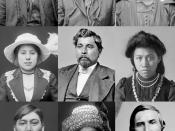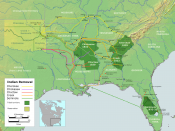IntroductionWhen the continent of North America was first colonized, there was a long lasting conflict between the Native Americans and the white settlers. The areas that were settled first by the white settlers became overcrowded; this forced the new settlers that were arriving to settle in the outlying lands, which belonged to the Native Americans. The Native Americans were not willing to leave their land for the white settlers (McGill, 2005). McGill (2005) states ÃÂThe United States government created many oppressive, anti-Indian land-reform policies throughout the years between the war of 1812 and the Civil War.ÃÂThe goal of the land-reform policies was to remove the five tribes that lived on the land that was located east of the Mississippi River, so that it could be settled by white settlers. The five tribes were to be moved to land that was located in the west, which was dry and arid (McGill, 2005).
McGill (2005) states, ÃÂThe Proclamation of 1763 forced colonists to remain east of the Appalachian Mountains, and all land west of this natural barrier was reserved for Native Americans. However, by the 1800ÃÂs, American cities were growing and the settlers were itching to move westward onto Native American lands.ÃÂ The routes that the Native Americans would be moved along would become known as the Trail of Tears.
Journal EntryToday, our tribal leaders told us of the white men getting Chief Black Hawk, Leader of the Fox and Sauk tribes, to move his people west, across the Great River. Our leaders told us how chief Black HawkÃÂs people found the conditions of this new land unfavorable and out of desperation, he led his people back to their homeland. We were told that when Black HawkÃÂs people returned, they were met by the white manÃÂs army.


